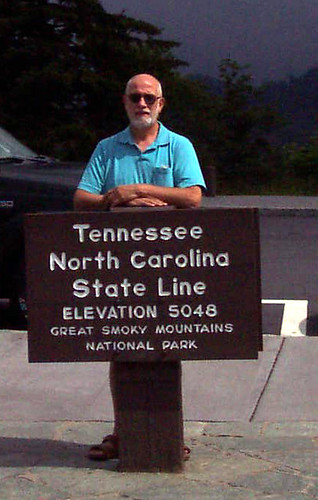I found it interesting to see steam rising in what seemed to be just the fields. Then we saw a bubbling pots, not quite the fountains with with lots of steam. Then I saw Old Faithful! It was everything my imagination said it was going to be. After that, I really lost interest in geysers. However, the very last thing I saw in Yellowstone Park was Beryl Spring, the most amazing blue (Beryl for the stone) bubbling spring. (See pic at right)
The most outstanding feature of this Park, for me, was the Grand Canyon of the Yellowstone River. It was not very wide but it was very deep. The colors of the rock were outstanding in the gorge through which the river flowed. In fact, I decided that this is where the Yellowstone River, Lake and Park get their name. I thought this Park was about geysers. In fact, that's all the introductory video talked about. I was totally taken by surprise on the second day when we walked onto the viewing platform for the gorge. I can't pick a favorite picture so you'll have to go the set of pics called Yellowstone and select view as slideshow. There are two falls here in the river, both of which are striking. I also enjoyed Tower falls.
I was impressed by Mammoth Hot Springs with its two years of salt runoff from the Hot Springs. I was disappointed that the springs weren't flowing down over the tiers. I saw both from below and above in the most impressive was out of road that led around the higher springs. on, I had a wonderful experience.
We drove down the Idaho side of the Grand Teton's this morning. With the mountains to our east, Peggy did a fantastic job capturing the dark outline of the mountains against the brightness of the sky (see pic at right). As this mountain chain came into view, it was misty, smoky, looming against the eastern sky. I was reminded so much of the great Smokies near Melissa's home in North Carolina.
As always, I think about the land of the crops. While in Yellowstone, I saw a lodge pole pine everywhere. Something like 80 to 85% of the growth in the park is this pine. The name is very descriptive; it is all pinched right and mostly about six to 10 inches in diameter. Perfect for Indian lodges. However this tree has a peculiarity. Its seeds, only open as result of fire. Therefore, after a forest fire, the trees are self seeking an entire new forest grows up at the same time and therefore the new force is about the same size no matter where you look. This is what intrigues me. Several times we went by signs telling you they hear of the forest fire which burned that section of Yellowstone. These areas were covered with new growth, of a uniform height, interspersed with the trunks of some of the old trees still standing well above the new growth. One sign said forest fire in 1987 which meant that the new growth was 20 years old. This new growth forest was composed of trees not more than 10 feet tall (might have been seven to 10). Does it seem reasonable to you that tree is growing for 20 years would've reached only this height when they reach 30 feet or more when mature. Of course, I cannot find how long they must grow to reach that height. Can anybody help me?
As we drove across Idaho, I was struck by the fields of wheat and maybe potatoes. The land was rolling up the planted fields went up and over and down these hills. A little bit later we started driving up this paper, longer hills on two plateaus where the fields suddenly became irrigated, growing the same crops. The size of grain silos or elevators increased as to their number. Then we drove further up, to a higher plateau, where suddenly the land seemed worthless. We went miles without spotting any sign of human habitation. Off in the distance we started seeing mountains and after some time, we got near enough to see they were barren except for a few scattered trees. They were sharply ridged as if from erosion. None of the three of us would ever agree to live in this area.

1 comment:
here's some info on lodgepole pines
http://www.na.fs.fed.us/spfo/pubs/silvics_manual/Volume_1/pinus/contorta.htm
Post a Comment